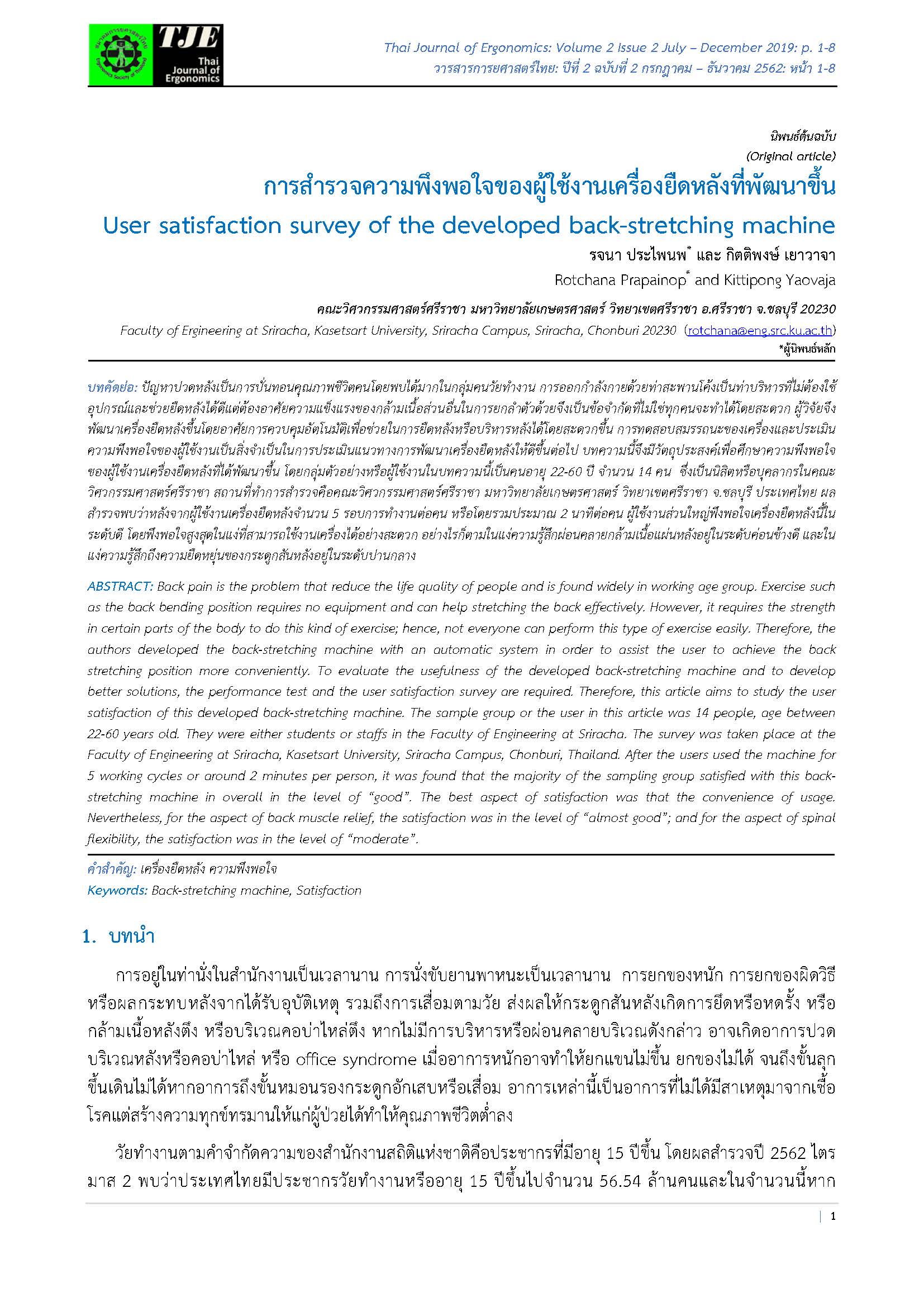User satisfaction survey of the developed back-stretching machine
Main Article Content
Abstract
Back pain is the problem that reduce the life quality of people and is found widely in working age group. Exercise such as the back bending position requires no equipment and can help stretching the back effectively. However, it requires the strength in certain parts of the body to do this kind of exercise; hence, not everyone can perform this type of exercise easily. Therefore, the authors developed the back-stretching machine with an automatic system in order to assist the user to achieve the back stretching position more conveniently. To evaluate the usefulness of the developed back-stretching machine and to develop better solutions, the performance test and the user satisfaction survey are required. Therefore, this article aims to study the user satisfaction of this developed back-stretching machine. The sample group or the user in this article was 14 people, age between 22-60 years old. They were either students or staffs in the Faculty of Engineering at Sriracha. The survey was taken place at the Faculty of Engineering at Sriracha, Kasetsart University, Sriracha Campus, Chonburi, Thailand. After the users used the machine for 5 working cycles or around 2 minutes per person, it was found that the majority of the sampling group satisfied with this back-stretching machine in overall in the level of “good”. The best aspect of satisfaction was that the convenience of usage. Nevertheless, for the aspect of back muscle relief, the satisfaction was in the level of “almost good”; and for the aspect of spinal flexibility, the satisfaction was in the level of “moderate”.
Article Details

This work is licensed under a Creative Commons Attribution-NonCommercial-NoDerivatives 4.0 International License.
References
การสำรวจภาวะการทำงานของประชากร (LFS) ไตรมาส 2 ปี 2562 สำนักงานสถิติแห่งชาติ อ้างอิงในศูนย์ข้อมูลแรงงานแห่งชาติ [เข้าถึงเมื่อ 25 พ.ย.2562]. เข้าถึงได้จาก http://nlic.mol.go.th
กรมการแพทย์. รพ.นพรัตนฯ เผยวัยแรงงานอายุตั้งแต่ 15 ปีขึ้นไปป่วยโรคปวดหลังมากสุด [อินเทอร์เน็ต]. กรุงเทพฯ: กรมการแพทย์; 2562 [เข้าถึงเมื่อ 28 ก.ย.2562]. เข้าถึงได้จาก: https://pr.moph.go.th/?url=pr/detail/2/02/128287
Nambi GS, Inbasekaran D, Khuman R, Devi S, Shanmugananth, Jagannathan K. Changes in pain intensity and health related quality of life with Iyengar yoga in nonspecific chronic low back pain: A randomized controlled study. Int J Yoga 2014;7(1):48-53.
Long R. Yoga Mat Companion 3: Anatomy for backbends and twists. New York: Bandha Yoga Publications; 2010.
เสก อักษรานุเคราะห์. อันตรายมืดจากโยคะ อ้างอิงในมูลนิธิโรคข้อในพระราชูปถัมภ์ในสมเด็จพระเทพรัตนราชสุดาฯ สยามบรมราชกุมารี [เข้าถึงเมื่อ 25 พ.ย.2562]. เข้าถึงได้จาก http://www.thaiarthritis.org
สิทธิบัตรเลขที่ US 6,213,923 B1 Back exercise device, Publication date: April, 10, 2001.
สิทธิบัตรเลขที่ WO2018048860 Lower back exercise apparatus, Publication date: March, 15, 2018.
สิทธิบัตรเลขที่ US20170065852 Back machine, Publication date: March, 9, 2017.
สิทธิบัตรเลขที่ US3081085A Back posture and stretch board, Publication date: March, 12, 1963.
สิทธิบัตรเลขที่ US5472401A Ramped horizontal, on bench, adjustable stretch bench for relieving a user back pain, Publication date: December, 5, 1995.
สิทธิบัตรเลขที่ US5100131A Back muscle exercising and stretching apparatus, Publication date: March, 31, 1992.


